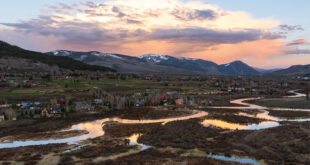Throughout the year, the Crested Butte News will ask various members of the community to write a guest editorial for page 2. This week, Gunnison County Electric Association board member and Colorado Rural Electric Association vice president Chris Morgan takes the spot.
—Mark Reaman
If your electric bill was $100 last month, it could jump to $140 for the same amount of electricity in the near future. Sound good to you?
I had the privilege of sharing lunch with Colorado Public Utilities Commission chairman Ron Binz a couple of weeks ago. Over our meal and our discussion, he said “Your electric utility needs to overlook cost and embrace a $0.04 per KWh increase in your rates in order to mitigate carbon emissions under the proposed Obama cap and trade proposal.” A four-cent per KWh rate adder—that is roughly a 40 percent increase in your monthly electric bill. If your electric bill was $100 last month, in the future it could be $140.
Now, do I oppose increasing rates for the purpose of reducing carbon emissions? No I don’t. However, while the Obama CO2 cap and trade proposal will raise $645 billion over the next 10 years, the administration is only allocating 150 billion of those dollars to programs that actually produce a meaningful reduction in CO2 emissions. The rest of the money is being redistributed to the public through the “making work pay” program in order to mitigate the economic hardship higher energy bills inflict on low income families. My question to the administration is “Why would a plan designed to reduce CO2 not use 100 percent of those funds to implement CO2 reduction programs and R&D for new CO2 reduction technologies?”
Next, I read in last week’s paper a letter from Chris Menges, representing both HCCA and ACE, asking our community to support Colorado PUC regulation of Tri-State Generation and Transmission’s integrated resource plan. Am I opposed to having a government agency look over Tri-State’s long-range plan? Not really. But understand that it will come at a cost, and may not provide the public much benefit.
If regulation of Tri-State by the PUC costs half of what it costs Xcel energy, an investor-owned utility that serves the majority of customers in Colorado, then Gunnison County Electric Association’s share of that cost would be many thousands of dollars. As a not-for-profit utility, that cost would simply flow straight to the rate payer—therefore raising your electric bill. And in my opinion, PUC regulation is not necessary because GCEA, as well as Tri-State, are both member-owned not-for-profit utilities run by a board of directors who were elected by you, the membership. To me, that sounds like the members of GCEA, who elect our board, have a very strong regulatory position already. Your vote speaks loudly—and we listen.
Your board of directors at GCEA has been very aggressive in developing and providing programs in the areas of renewable energy, energy conservation and demand side management—all of which help reduce CO2 emissions. Even though we are the second smallest electric utility in the state, we have dedicated two full-time staff members to implementing a significant list of programs designed to help our members better use energy resources.
GCEA has energy efficiency and renewable energy loan programs, efficient appliance rebates and a very successful wind power program. GCEA has a compact fluorescent bulb subsidy program and supports energy audits of homes and businesses. GCEA is executing the Governor’s Energy Office Insulate and Seal program by offering grants to improve the insulation in your home. GCEA is a founding member of the Office for Resource Efficiency and is its largest financial contributor. GCEA funded matching grants to put solar panels on the Crested Butte and Gunnison schools, and I might mention the Gunnison school is not even in GCEA’s service territory. GCEA has spent more money on conservation, efficiency and renewable programs than any other organization in the valley, and consequently our efforts have resulted in more CO2 emissions reductions than any other entity in our valley. GCEA is a clear leader in our community. (www.gcea.coop for more information on programs.)
If we need to pass expensive regulations, let’s not enact costly CO2 cap and trade policies that merely redistribute monies or create expensive PUC regulation. GCEA has demonstrated that local CO2 emissions reduction programs are not only possible, but that they are working. How many more programs could our community implement if we kept locally the funds potentially slated to go to the Federal Government or to PUC regulation?
Currently, local governments and utilities are partnering to enact programs to meet emission reduction goals through the ongoing coordinated energy planning process. We need to let that process come to a conclusion. The final plan will create local jobs, local spending and meaningful local energy savings and emissions reductions. I fear that if the federal and state governments tax our energy use too heavily, there will be nothing left for our local efforts.
Mr. President and Mr. Binz, please let us create our own stimulus package. It is already working.
 The Crested Butte News Serving the Gunnison Valley since 1999
The Crested Butte News Serving the Gunnison Valley since 1999





